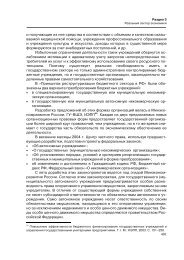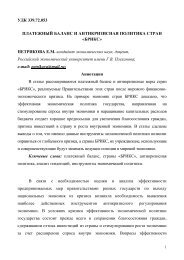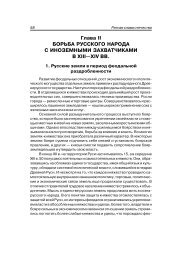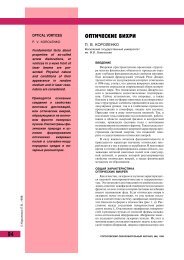Ensuring Strategic Stability in the Past and Present:
Ensuring Strategic Stability in the Past and Present:
Ensuring Strategic Stability in the Past and Present:
You also want an ePaper? Increase the reach of your titles
YUMPU automatically turns print PDFs into web optimized ePapers that Google loves.
End Notes1. Critics claim that <strong>the</strong> pr<strong>in</strong>ciple of strategic stability, which is based on mutual nuclear deterrence, epitomizes a confrontational approach <strong>and</strong>that it supposedly h<strong>in</strong>ders <strong>the</strong> development of political relations with <strong>the</strong> United States. I can counter such criticism by not<strong>in</strong>g that Russia’s nationalsecurity <strong>in</strong>terests cannot be sacrificed even for <strong>the</strong> sake of very good political relations with <strong>the</strong> United States. Critics also note that <strong>the</strong> traditionalformula of strategic stability is based on <strong>the</strong> “dyad” relationship; <strong>the</strong>refore, it is practically impossible to <strong>in</strong>volve a third nuclear power <strong>in</strong> <strong>the</strong> processof limit<strong>in</strong>g <strong>and</strong> reduc<strong>in</strong>g nuclear weapons.2. Y. A. Trutnev, “Na blago Rossii: K 75-letiu akademiki RAN Yu. A. Trutneva” (“For <strong>the</strong> Benefit of Russia: Dedicated to <strong>the</strong> 75th Anniversary ofAcademician of <strong>the</strong> Russian Academy of Sciences Y. A. Trutnev”), Sarov, Saransk: Krasnyi Oktyabr, 2002, p. 334.3. See Graham Allison, “Nuclear Terrorism: The Ultimate Preventable Catastrophe,” New York: Owl Books / Henry Holt, 2005; A. A. Kokosh<strong>in</strong>,“Zametki o probleme yadernogo terrorizma v sovremennoi mirovoi politike” (“Notes on <strong>the</strong> Problem of Nuclear Terrorism <strong>in</strong> ContemporaryInternational Politics”), Moscow: Len<strong>and</strong> / URSS, 2006.4. “Brown pushes for world reduction of nuclear weapons as he makes Iran offer,” Guardian, 17 March 2009.5. The October 1962 Cuban Missile Crisis—called “<strong>the</strong> Caribbean Crisis” <strong>in</strong> Russian—is an event of utmost significance <strong>in</strong> world history. Itdem<strong>and</strong>s <strong>the</strong> thoroughgo<strong>in</strong>g exam<strong>in</strong>ation of scientists <strong>and</strong> specialists, <strong>and</strong>, at a m<strong>in</strong>imum, a general exam<strong>in</strong>ation by state leaders, politicians ofvarious ranks <strong>and</strong> <strong>the</strong> supreme military comm<strong>and</strong>. I would note <strong>the</strong> follow<strong>in</strong>g works on this subject: A. F. Dobryn<strong>in</strong>, “Sugubo doveritelno: Posolpri sheti prezidentakh SShA: 1962–1968” (“Strictly Confidential: Ambassador to Six U.S. Presidents: 1962–1968”), Moscow, 1997; Graham Allison<strong>and</strong> Philipp Zelikow, “Essence of Decision: Expla<strong>in</strong><strong>in</strong>g <strong>the</strong> Cuban Missile Crisis,” New York: Pearson Longman, 1999; A. Fursenko <strong>and</strong> T. Naftali,“Adskaya igra: Sekretnaya istoriya karibskogo krizisa 1958–1964” (“Hellish Game: A Secret History of <strong>the</strong> Caribbean Crisis: 1958–1964”), Moscow:Geya iterum, 1999; <strong>and</strong> S. A. Mikoyan, “Anatomiya karibskogo krizisa” (“Anatomy of <strong>the</strong> Caribbean Crisis”), Moscow: Academia, 2006.6. Allison <strong>and</strong> Zelikow, “Essence of Decision: Expla<strong>in</strong><strong>in</strong>g <strong>the</strong> Cuban Missile Crisis,” 2nd ed., New York: Pearson Longman, 1999.7. George Shultz served as U.S. secretary of state for seven years <strong>in</strong> <strong>the</strong> adm<strong>in</strong>istration of President Ronald Reagan. He saw action with <strong>the</strong> U.S.Mar<strong>in</strong>es <strong>in</strong> World War II.8. William Perry headed <strong>the</strong> U.S. Department of Defense <strong>in</strong> <strong>the</strong> 1990s dur<strong>in</strong>g <strong>the</strong> presidency of Bill Cl<strong>in</strong>ton. In <strong>the</strong> 1970s he served as undersecretaryof defense for research <strong>and</strong> eng<strong>in</strong>eer<strong>in</strong>g dur<strong>in</strong>g <strong>the</strong> Jimmy Carter adm<strong>in</strong>istration. He is considered to be <strong>the</strong> “godfa<strong>the</strong>r” of an entire series ofhigh-precision long-range conventional weapons. Perry is a professor at Stanford University. He has served on <strong>the</strong> board of directors of a numberof large science-<strong>in</strong>tensive American corporations.9. Henry A. Kiss<strong>in</strong>ger served as national security advisor to <strong>the</strong> president of <strong>the</strong> United States for a long period of time. He is one of <strong>the</strong> mostprom<strong>in</strong>ent political scientists <strong>and</strong> historians specializ<strong>in</strong>g <strong>in</strong> diplomacy <strong>and</strong> <strong>in</strong>ternational politics. He became a public servant after work<strong>in</strong>g atHarvard University where, among o<strong>the</strong>r th<strong>in</strong>gs, he wrote “Nuclear Weapons <strong>and</strong> Foreign Policy” (1957), which became one of <strong>the</strong> classical works<strong>in</strong> this field. He fought <strong>in</strong> World War II. Kiss<strong>in</strong>ger is an author of a number of fundamental works on diplomacy, political science <strong>and</strong> <strong>in</strong>ternationalrelations, which were published after he had f<strong>in</strong>ished his political <strong>and</strong> diplomatic career. His works <strong>in</strong>clude “Diplomacy,” a Russian translation ofwhich was published <strong>in</strong> Russia <strong>in</strong> 1994.10. Sam Nunn chaired <strong>the</strong> United States Senate Committee on Armed Services for a number of years. In <strong>the</strong> 1980s, he played an important role<strong>in</strong> preserv<strong>in</strong>g <strong>the</strong> 1972 Treaty on <strong>the</strong> Limitation of Anti-Ballistic Missile Systems, publicly oppos<strong>in</strong>g <strong>the</strong>n-U.S. President Ronald Reagan <strong>and</strong> o<strong>the</strong>rproponents of <strong>the</strong> <strong>Strategic</strong> Defense Initiative.11. See, for <strong>in</strong>stance: G. D. Kulichkov, VNIIEF, “Istoricheskii ocherk: 1946–1992,” Sarov: RFYaTs-VNIIEF, 1998, p. 92.12. The Interceptor Missile V-1000 had a maximum velocity of 1,000 meters per second. It could <strong>in</strong>tercept a target at an altitude of 25 km. See I. D.Yevtiev, “Iz istorii sozdania zenitnoraketnogo shchita Rossii – o sozdanii zenitnykh upravlyayemykh raket i zenitno-raketnykh kompleksov v Rossiii stranakh NATO” (“From <strong>the</strong> History of <strong>the</strong> Development of <strong>the</strong> Missile Defense Shield of Moscow: On <strong>the</strong> Development of Guided Missilesfor Air Defense Systems <strong>in</strong> Russia <strong>and</strong> NATO countries”), Moscow: Vyzovksaya kniga, 2000, p. 75.13. The decision of <strong>the</strong> country’s leadership on national missile defense is documented <strong>in</strong> <strong>the</strong> jo<strong>in</strong>t statement of <strong>the</strong> Central Committee of <strong>the</strong>CPSU <strong>and</strong> <strong>the</strong> Soviet Cab<strong>in</strong>et of M<strong>in</strong>isters, released on 4 May 1963 <strong>and</strong> titled “On <strong>the</strong> development of <strong>the</strong> missile defense of <strong>the</strong> national territory.”See M. Pervov, “Sistemy raketno-kosmicheskoi oboroni sozdavalis tak” (“This is How <strong>the</strong> Space <strong>and</strong> Missile Defense Systems of <strong>the</strong> Country wereCreated”), 2nd ed., AVIARIUS-XXI, 2004, p. 153.14. Pervov, p. 152.15. Yevtiev, pp. 123–126.16. Ibid., p. 172.17. Pervov, p. 172.62<strong>Ensur<strong>in</strong>g</strong> <strong>Strategic</strong> <strong>Stability</strong> <strong>in</strong> <strong>the</strong> <strong>Past</strong> <strong>and</strong> <strong>Present</strong>: Theoretical <strong>and</strong> Applied Questions
















